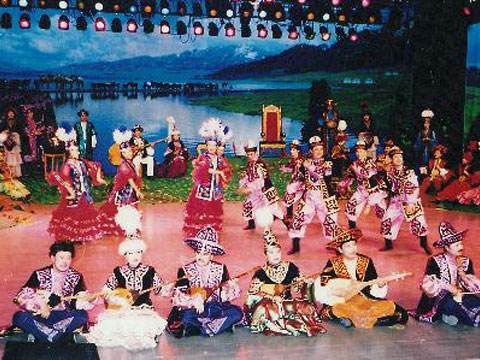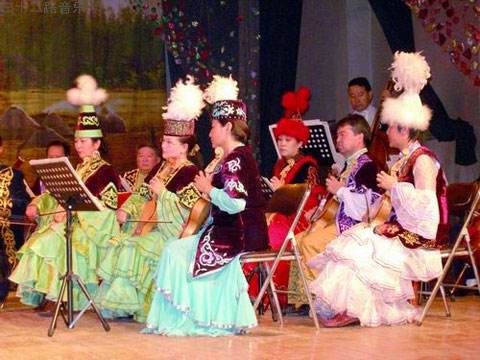Sixty-two Kuoner.Living Fossilon the Grassland
6 min readThe Sixty-two Kuoner is folk classical music of the Kazakh ethnic group,which means 62 sets of coherent,beautiful and lyrical pieces of music.It is performed mainly with instrumental music,in combination with folk songs,dances,talking and singing and playing and singing.Due to such outstanding value,the Sixty-two Kuoner is acclaimed as a livingfossil of grassland music and has been inscribed on the Representative List of the Second Batch of National Intangible Cultural Heritage.the Kazakhs with nomadic husbandry as their main way of production and life at a corner of Xinjiang,in the inheritance of grassland civilization,oblivious to the change of time have maintained the Sixty-two Kuoner that originated from the daqu of the han and Tang dynasties and hence provides a possible method for looking for the ancient daqu of the han and tang dynasties and the daqu of the Song Dynasty(960 AD to 1279 AD.
A Sixty-two Kuoner concert
Nomadic husbandry and farming are always brothers.One of the features of the syster of grassland culture that differs from agricultural culture is the totally different modes of memorizing.Agricultural culture due to its comparatively stable way of production and life,features terraced and uniform rice paddies,so they pay more attention to the recording.

sorting out and preservation of writing system. the ideological form of times or city elites, books, unofficial history and notes are the main ways of spreading. Of course, in the system of civil society, there is also the folk memory system apart from clan genealogy. Yet in general, the difference in the systems of agricultural culture and grassland culture is enormous.
The mode of memory of the people on the grasslands has a direct link to their way of production and lifestyle. It was hard for tribes living in groups or tribes living scattered to’e in a fixed place owing to the nomadic life style around the year, instead they are always moving. Nomadic husbandry is the carrier of grassland culture and the moving feature of has kept its ancient memory system. The unique climate in particular resulted in the culture their life determines the moving feature of their culture. In the meanwhile, grassland nomadic people’s sensitiveness about the change in season. So grassland culture has amore sensual and modest feature The Sixty-two Kuoner of the Kazakh ethnic group is an excellent carrier of this nomadic symbol.

A Sixty-two Kuoner concert
Scholars of contemporary society has confirmed through studies on history, archeologyfolklore and anthropology that the ancestors of the Kazakhs were Saka, Usun, Darouzhi Kangqu, Yueban, etc. There are three theories about the Usun people. One is that they were the Hun, for the reason that the Usun royal family had always kept close relations with theHun, and they had similar customs. The second theory is that they are turks, for the reason that the legends about the founders of Usun and turk were both related to wolves. There is a description in”Traditions in Western Regions”in the Book of Han, “of all the tribes in the Western Regions, their appearances were the most exotic. Today’s Hun people have green eyes and red beard, like monkeys. They are of that race “As an ancient tribe, Usun still has descendants today. Kangqu and Yueban were two large cultural kingdoms in ancient time and Kangqu Music and Yueban Music were once very popular. Since they were combined with the culture of Qiuci(near today’s Kuqa county), the famous cultural center in the Western Regions during the Western Han Dynasty(206 BC to 25 AD), that means Usun Music as the symbol, and then had exchange with the cultural system represented 6 uc’ adic grassland culture at first had close connection with the semi-agricultural and semi-noma cultural system with the culture of the Western Regions as the representation and Qi Chang’ an, the most important one of the Central Plains culture. This has definite records in historical materials.
Then the two famous princesses of the Western Han, Xijun and Jieyou, married the kings of Usun to cement friendly relations with Usun, they brought court bands with them, and when the king of Usun went to Chang’ an, he also brought with him dance with musical accompaniment Music has no boundary and discrimination against races and culture shortens the distance between two places. Music acted as the best carrier for strengthening relationship between the inland and the Western Regions. Dishi, the first daughter of rincess Jieyou and King Wenggui, was sent to Chang’ an to study Han Music for five years and married the king of qiuci Jiangbin after shes back. the traditions in Western Regions in the book of han records that in the first year of the reign of Yuankang (65 BC), Jiangbin and his wife went to the han court, “The King of Qiuci and his wife were both granted seals and belts, his wife was bestowed the title of princess and was granted horses, flags and drums and tens of singers and instrumental players. This promoted the exchange between Han Music, Usun Music and Qiuci music.
The nomadic Kangqu tribe had a close relationship with the dynasty on the Central Plains. Kangqu instruments and dance with musical accompaniment started to spread to the Central Plains during the Wei, Jin, Southern and northern Dynasties(220 Ad to 589 AD)It was very popular during the Tang Dynasty, and the most favored one is Huxuan dance Bai Juyi, the distinguished poet of the Tang dynasty wrote in his Huxuan Dancers: Huxuan Dancers, huxuan dancers her heart beats with the strings and her hand with the drum at the sound of the string and drum, she lifts her sleeves, swirls and dances like snow flying Huxuan Dancers, come from Kangqu, tens of thousands of miles away from the east. Thispoem gives a vivid description of Kangqu Huxuan Dance and shows that Kangqu dance was so popular in the Central Plains that the officials and beauties in the court started to learn Huxuan Dance. Apart from written records the murals in the dunhuang grottoes also havedescription of Huxuan Dance. Besides Huxuan Dance, the well-known dances also included Huteng Dance and zhezhi dance. Undoubtedly, the music used as accompaniment was similar to today’s Kuiyi”of the Kazakh ethnic group. From the moves of jumping, stamping and the rhythm slow and fast, we can imagine the vividness of the tune and the large number of instruments used. It also shows that the Western Regions music included by the daqu of the tang Dynasty have already been a combination of songs, dances and instruments.
The well-known neW, refreshing Xianghe Daqu and Pan Gu dance which belong to the daqu of the han Dynasty directly enlightened Yanyue of the Sui and Tang dynasties(581AD to 907 AD) in real sense Yanyue of the Sui and Tang dynasties refers to court banquet music accompanying dance with the famous Qiuci Music and Yizhou music as its two important components. Although on the stage were still music and dances, the size and content of the dance with musical accompaniment at that time had already reached thepinnacle in the history of chinese dance with accompaniment. the rich forms, diverse varieties, extraordinary skills and size are all unprecedented. Yanyue of the Sui and Tang dynasties became the main melody of court music and also became popular among the common people. For a time, fans of Yanyue emerged in and out the court. According to the Records of music”in the Book of Sui, when Emperor Wen established the Sui Dynasty, he ordered his officials to set up seven ensembles which included Xiliang Music, Qingshang Music, Gaoli Music, Indian Music, An Kingdom Music, Qiuci Music and Wenkang music Emperor Yang of the Sui Dynasty, who was a music lover, added two ensembles of the Western Regions: Kang Kingdom Music and Shule Music, thus forming the famous Nine Ensembles of the Sui Dynasty. Emperor Taizong of the Tang Dynasty unprecedented ncreased the ensembles to ten by adding another ensemble of the Western Regions music, Gaochang music. He also collected wind and drum music of the Western Regions, and other music of Xianbei, Tuyuhun and Buluoji tribes, which showed the emperor’s favor towards daqu of the Western Regions. When Emperor Xuanzong of the tang Dynasty musically gifted, ascended to throne, he set up Zuobuji(musicians sit during performance) and Libuji(musicians stand during performance), and set up an internal institute engaged in matters related to Yanyue and he even took part in the training. With the support of Emperor Xuanzong, daqu of the Western Regions made up two-thirds of the dances with musical accompaniment of the Great Tang Empire. This emperor, out of passion, trust and appreciation, pushed Yanyue up to an unprecedented pinnacle Daqu finished its changewith the love and obsession of the Great Tang Empire and became the daqu of the tang Dynasty which has lasted until now.








